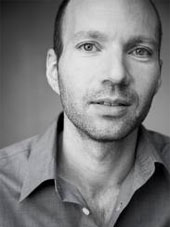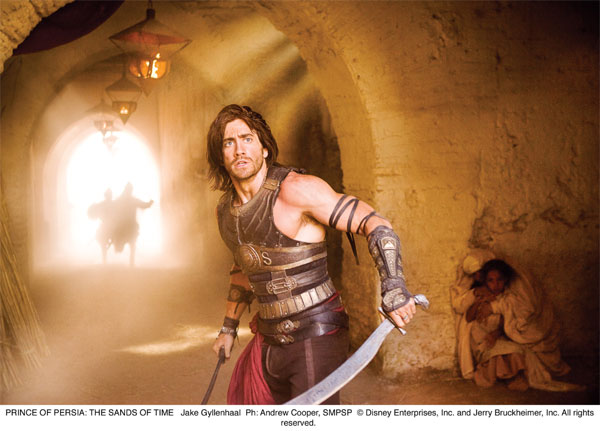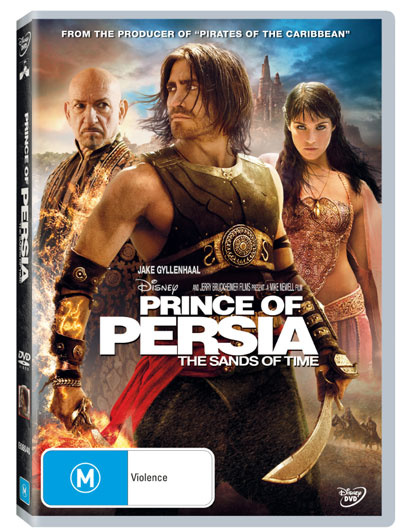|
PRINCE OF PERSIA
JORDAN MECHNER Q & A
 Jordan
Mechner is the creator of the hugely successful video game, “Prince of Persia.”
Given the popularity of the game, it was only a matter of time before Hollywood
came knocking, and sure enough, the fourth installment of the Prince of Persia
saga, “Prince of Persia: The Sands of Time,” is now being turned into a big
budget adventure film directed by Mike Newell (best known for “Four Weddings and
a Funeral” and “Harry Potter and the Goblet of Fire”) and produced by Jerry
Bruckheimer, the man behind myriad hits including “National Treasure” and the
three “Pirates of the Caribbean” films. The new film has a cast led by Jake
Gyllenhaal in the title role, as well as Sir Ben Kingsley, Alfred Molina, and
newcomer Gemma Arterton, who gave a memorable performance in the last James Bond
film, “Quantum of Solace.” True to form for Jerry Bruckheimer, the king of the
Hollywood blockbuster, “Prince of Persia: Sands of Time” is executed on an
incredibly vast scale. The film had a crew of more than 2,000 and was shot over
a period of five months on locations in Morocco and at London’s famed Pinewood
Studios. Meanwhile, a casbah that the filmmakers constructed outside Marrekesh
was reputedly one of the largest sets created for a Hollywood film in the last
twenty years. We spoke to Jordan Mechner on one of the film’s real-life
locations: a blisteringly hot but picture-perfect oasis, just outside the
southern Moroccan city of Ouarzazate. As temperatures soared to 50 degrees
Celsius and production assistants advised us to be on the lookout for snakes and
scorpions amid the palms trees, Mechner talked about bringing “Prince of Persia”
to the big screen and his hopes for the film, which is due for release in the
spring of 2010. Jordan
Mechner is the creator of the hugely successful video game, “Prince of Persia.”
Given the popularity of the game, it was only a matter of time before Hollywood
came knocking, and sure enough, the fourth installment of the Prince of Persia
saga, “Prince of Persia: The Sands of Time,” is now being turned into a big
budget adventure film directed by Mike Newell (best known for “Four Weddings and
a Funeral” and “Harry Potter and the Goblet of Fire”) and produced by Jerry
Bruckheimer, the man behind myriad hits including “National Treasure” and the
three “Pirates of the Caribbean” films. The new film has a cast led by Jake
Gyllenhaal in the title role, as well as Sir Ben Kingsley, Alfred Molina, and
newcomer Gemma Arterton, who gave a memorable performance in the last James Bond
film, “Quantum of Solace.” True to form for Jerry Bruckheimer, the king of the
Hollywood blockbuster, “Prince of Persia: Sands of Time” is executed on an
incredibly vast scale. The film had a crew of more than 2,000 and was shot over
a period of five months on locations in Morocco and at London’s famed Pinewood
Studios. Meanwhile, a casbah that the filmmakers constructed outside Marrekesh
was reputedly one of the largest sets created for a Hollywood film in the last
twenty years. We spoke to Jordan Mechner on one of the film’s real-life
locations: a blisteringly hot but picture-perfect oasis, just outside the
southern Moroccan city of Ouarzazate. As temperatures soared to 50 degrees
Celsius and production assistants advised us to be on the lookout for snakes and
scorpions amid the palms trees, Mechner talked about bringing “Prince of Persia”
to the big screen and his hopes for the film, which is due for release in the
spring of 2010.
Q: You created this world and these characters, so I wonder how it feels
to be here on set in Morocco and see it all coming to life?
A: It’s an incredible rush. For the first day here I just had a big smile on my
face all day. I couldn’t stop marvelling at it all and it’s staggering to see
the sheer scale of this production and what’s involved in bringing it to life.
Through all the versions of the games I am so used to seeing concept art of
deserts and fictional Persian cities, and trying to make it look as real
possible, and suddenly here we are, and it’s a real desert and there are
scorpions and heat and palm trees.
Q: And snakes. You don’t think it might have been easier to do the whole
thing at Pinewood, do you?
A; [Laughs] That’s one thing I’m really delighted about with this production,
that Jerry [Bruckheimer] and Mike [Newell] have chosen to come and shoot in
Morocco. How many films have we seen where there’s an oasis, but it’s a set at a
studio? And it’s just not the same. I was at the casbah this morning where we
are going to be shooting in a few days and you can’t tell where the set ends and
the real city begins. You can’t tell if they are extras standing around between
takes or the people who live there.
Q: To go back to the origins of the “Prince of Persia,” the first version
of the game came out in 1989, which was sort of the Stone Age for the video game
industry…
A: Yes, and if any of us back then had been able to fast forward 20 years and
see what video games have become today with their incredible beauty and
technical sophistication, we’d think we were dreaming. It was handicraft in
those days. “Prince of Persia” was just me with an Apple II computer in my room
in my parents’ house in New York. My dad contributed the musical score, which
was really just a series of beeps and buzzes, and my brother did the running and
jumping, which I videotaped and used as a guide for the movement of the
characters. It was really pretty basic and the characters on the screen were
just 40 pixels high.
Q: The game was a huge success of course. Why do you think that was?
A: I think that when a game really clicks. It’s a combination of being fun to
play, having that ineffable addictive quality, and pushing the envelope in some
way in terms of design and technology. There’s also the basic, emotional
response where players have to decide whether this is a world that they want to
enter. My previous game, “Karateka,” had been set in medieval Japan with Mount
Fuji in the background, and I thought that the exoticism of the setting had been
important for the game’s success. So for the new game I wanted to find something
that was at least as cool and I started thinking about the stories from the
“Arabian Nights” that I’d picked up from cartoons and picture books and older
Hollywood films like “The Thief of Bagdad.” It was this fantastic world of
legend and mythology that hadn’t yet been done, and it was perfect for the kind
of running, jumping, swashbuckling action that I wanted to do.
Q: Talking of swashbuckling, the game had a sort of “Indiana Jones” feel
to it. Was “Indiana Jones” an inspiration?
A: Yes, a direct inspiration. I thought it would be cool to do a video game with
the sort of action you get in the first ten minutes of “Raiders of the Lost Ark”
where Indiana Jones runs, jumps over a pit and misses, but grabs on with his
fingernails and kind of claws his way back up. The characters in video games
were usually weightless back then: they would run and jump, but you never felt
that the character could really get hurt. I wanted a character that was flesh
and blood and, when he fell on spikes, it hurt.
Q: Did you always hope that the game would become a film?
A: I thought it had potential, but I didn’t realise just how complicated it is
to get a film made. When I first came to Hollywood people were amused at my
naiveté because I actually thought we were going to make a movie right away.
With games, it’s like, “Let’s make the game, and let’s ship it.” It’s not like
that with movies. They spend years in development. “The Sands of Time” has taken
four years to get made, which to me is a really long time, but my Hollywood
friends just shake their heads and say, “You’re so spoiled, you don’t realize
how rare this is.”
Q: Did you feel protective of the game at all? Was it important to find
the right filmmakers to put it on screen?
A: Absolutely. But when Jerry Bruckheimer and Disney expressed interest, there’s
no one better at making movies like this, and I knew the film would be made in
the way and on the scale we’d envisioned. Then when Jerry brought in Mike
Newell, who’s a fantastic director and an actors’ director, I had complete
confidence that he would cast not just the lead role well, but also an entire
ensemble of great actors, which is exactly what’s happened. And it’s funny,
because Sir Ben Kingsley was the inspiration for the character of the vizier in
the game. He was the actor whose likeness I gave to the artist who was working
on the “Sands of Time” game, and now here he is in the film version.

Q: How do you think fans of the game are going to react to the film? Will
it be what they hoped for?
A: I think what it ultimately comes down to is making a good movie and I have
very high hopes that we will deliver something that the fans will like. I
understand that if you love a video game or a novel, there’s probably always
this moment of initial resistance, this moment where you think, this isn’t the
way I imagined it. But if a film’s good, then after a minute or two that goes
out the window and you’re just caught up in the whole thing.
Q: How about the choice of Jake Gyllenhaal for the prince? Have you any
sense of fans’ reactions to that?
A: No flesh and blood actor can look exactly like the prince that millions of
fans have formed an image of in their heads. Also, if you look at the game, the
prince in “The Sands of Time” game looks nothing like the prince in the original
game. For me, Jake Gyllenhaal is a great choice.
Q: Well, he certainly looks the part on set…
A: Yes, when you see Jake in costume he looks fantastic. Also I think what’s
really important in casting the lead role in a movie is not just how an actor
looks, but who they are, just the personality they express in their being; and
Jake has a likability and a vulnerability about him that’s an important side of
the prince’s character, because the prince is an underdog in many ways. He’s
also a kind of trickster too, so you need a sense of him enjoying himself
despite all he’s up against, and yet be confident that in the end he will do the
right thing.

Prince of Persia will be available on Disney Blu-ray and DVD on the 20th of
October 2010
|